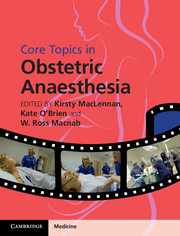Book contents
- Frontmatter
- Contents
- List of contributors
- Preface
- Section 1 Basic science, epidemiology and service organization
- Section 2 Obstetric aspects
- Section 3 Provision of anaesthesia
- 8 Incidental anaesthesia during pregnancy
- 9 Non-regional analgesia techniques for labour
- 10 Regional analgesia techniques for labour
- 11 Regional anaesthesia for operative delivery
- 12 General anaesthesia for caesarean section and transverse abdominal plane block
- 13 Anaesthesia for other obstetric indications: cervical suture, external cephalic version, controlled ARM, manual removal of placenta and perineal repair
- Section 4 Medical conditions in pregnancy
- Section 5 Postpartum complications and obstetric emergencies
- Section 6 Service organization
- Index
- Plate section
- References
9 - Non-regional analgesia techniques for labour
from Section 3 - Provision of anaesthesia
Published online by Cambridge University Press: 05 December 2015
- Frontmatter
- Contents
- List of contributors
- Preface
- Section 1 Basic science, epidemiology and service organization
- Section 2 Obstetric aspects
- Section 3 Provision of anaesthesia
- 8 Incidental anaesthesia during pregnancy
- 9 Non-regional analgesia techniques for labour
- 10 Regional analgesia techniques for labour
- 11 Regional anaesthesia for operative delivery
- 12 General anaesthesia for caesarean section and transverse abdominal plane block
- 13 Anaesthesia for other obstetric indications: cervical suture, external cephalic version, controlled ARM, manual removal of placenta and perineal repair
- Section 4 Medical conditions in pregnancy
- Section 5 Postpartum complications and obstetric emergencies
- Section 6 Service organization
- Index
- Plate section
- References
Summary
On 19 January 1847, James Young Simpson used diethyl ether to anaesthetize a woman with a deformed pelvis for delivery, to widespread opposition and consternation from his contemporaries, questioning its safety and his wisdom.
The controversy about the delivery of Queen Victoria's eighth child, Prince Leopald, in 1853 was such that her Court physicians publically denied that John Snow had anaesthetized her with ether to ease the pain. Four years later the issue was less controversial and it was widely acknowledged that Queen Victoria had received an anaesthetic to help her with the birth of Princess Beatrice, her ninth child. Anaesthesia for childbirth had become part of medical practice by 1860, in large part in response to the demands of women.
Our armamentarium for the management of labour has thankfully grown somewhat since the nineteenth century. This chapter will discuss the non-regional techniques (non-pharmacological and pharmacological) that are available in the UK.
The Cochrane Collaboration
In 2012 The Cochrane Collaboration summarized the evidence from Cochrane and non-Cochrane systematic reviews on the efficacy and safety of non-pharmacological and pharmacological interventions to manage pain in labour. This represented over 300 trials within 18 systematic reviews and they were able to categorize the interventions into: ‘What works’ (epidural, combined spinal and epidural, inhaled analgesia), ‘What may work’ (immersion in water, relaxation, acupuncture, massage, local anaesthetic nerve blocks, non-opioid drugs) and ‘Insufficient evidence to make a judgement’ (hypnosis, biofeedback, sterile water injections, aromatherapy, transcutaneous electrical nerve stimulation (TENS), parenteral opioids).
Non-pharmacological methods
Many non-pharmacological methods have been tried for the relief of labour pain, with varying success and much interindividual variability. Women may consider these options as an integral and important part of their labour experience, despite the benefits often being intangible and not easily documented by scientific method. It is important that the anaesthetic provider is aware of some of these techniques, their benefits and limitations, in order to be able to have a full and informed discussion with their patient. The 2012 Cochrane overview found some evidence to suggest that immersion in water, relaxation, acupuncture and massage may work, whilst there was insufficient evidence for hypnosis, biofeedback, sterile water injections, aromatherapy or TENS. Table 9.1 provides a useful summary.
- Type
- Chapter
- Information
- Core Topics in Obstetric Anaesthesia , pp. 54 - 60Publisher: Cambridge University PressPrint publication year: 2015



